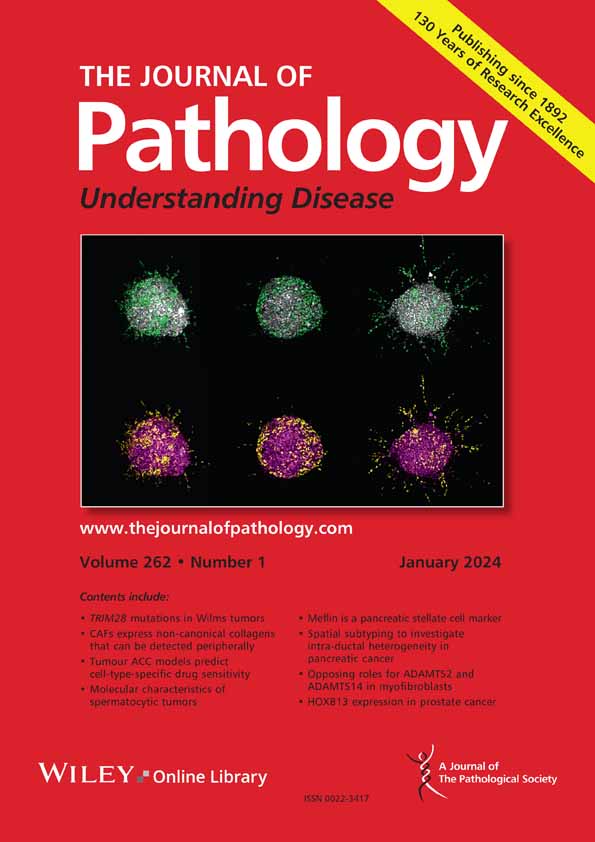Tenghao Yang, Xi Sun, Jiaming Chen, Jinqing Li, Chaoqun Liu, Jingwei Yu, Weiju Meng, Yongqiang Wang, Hao Yu, Jian Huang, Bo Wang
求助PDF
{"title":"ms4a4a阳性肿瘤相关巨噬细胞与膀胱尿路上皮癌患者预后不良和t细胞衰竭有关。","authors":"Tenghao Yang, Xi Sun, Jiaming Chen, Jinqing Li, Chaoqun Liu, Jingwei Yu, Weiju Meng, Yongqiang Wang, Hao Yu, Jian Huang, Bo Wang","doi":"10.1002/path.6465","DOIUrl":null,"url":null,"abstract":"<p>Tumor-associated macrophages (TAMs) have multiple potent functions in cancer representing important therapeutic targets. MS4A4A is a functional TAM marker with controversial implications for prognosis. This study aimed to evaluate the association between MS4A4A<sup>+</sup> TAM infiltration and clinical outcomes in urothelial carcinoma of the bladder (UCB), as well as their impact on the immune landscape. A total of 400 UCB patients from cohorts at Sun Yat-sen Memorial Hospital were analyzed. Immunohistochemistry was used to quantify MS4A4A<sup>+</sup> TAMs and assess their spatial distribution alongside various immune components, evaluate the benefit of Bacillus Calmette-Guérin (BCG) immunotherapy, and analyze survival outcomes. Additionally, matched UCB tissues were examined before and after recurrence or progression. We observed that MS4A4A<sup>+</sup> TAMs were present at higher levels in the stromal region compared to the intratumoral region, and correlated with advanced tumor stage and poor prognosis in both regions. No significant difference was observed in the number of MS4A4A<sup>+</sup> TAMs before and after recurrence/progression in the same patient. Stromal MS4A4A<sup>+</sup> TAMs were negatively correlated with BCG efficacy and recurrence-free survival. These TAMs were positively associated with CD8<sup>+</sup> T cells, Foxp3<sup>+</sup> regulatory T cells, immune checkpoints (PD-1, LAG-3, HAVcr-2, TIGIT), and anti-inflammatory molecules (TGF-β1, IL-4) in the same respective regions. Additionally, MS4A4A<sup>+</sup> TAMs expressed high levels of TGF-β1 and HAVcr-2 in UCB tissues. <i>In vitro</i>, IL-4 induced MS4A4A expression in mouse bone marrow-derived macrophages, while <i>Ms4a4a</i> knockdown reduced the anti-inflammatory molecule <i>Arg1</i> and increased pro-inflammatory molecule <i>Nos2</i> expression. These findings demonstrate that MS4A4A is a reliable prognostic marker and predictor of BCG response in UCB, highlighting its role in shaping the immune landscape and immunotherapy outcomes. © 2025 The Pathological Society of Great Britain and Ireland.</p>","PeriodicalId":232,"journal":{"name":"The Journal of Pathology","volume":"267 2","pages":"225-239"},"PeriodicalIF":5.2000,"publicationDate":"2025-08-13","publicationTypes":"Journal Article","fieldsOfStudy":null,"isOpenAccess":false,"openAccessPdf":"","citationCount":"0","resultStr":"{\"title\":\"MS4A4A-positive tumor-associated macrophages associate with poor prognosis and T-cell exhaustion in patients with urothelial carcinoma of the bladder\",\"authors\":\"Tenghao Yang, Xi Sun, Jiaming Chen, Jinqing Li, Chaoqun Liu, Jingwei Yu, Weiju Meng, Yongqiang Wang, Hao Yu, Jian Huang, Bo Wang\",\"doi\":\"10.1002/path.6465\",\"DOIUrl\":null,\"url\":null,\"abstract\":\"<p>Tumor-associated macrophages (TAMs) have multiple potent functions in cancer representing important therapeutic targets. MS4A4A is a functional TAM marker with controversial implications for prognosis. This study aimed to evaluate the association between MS4A4A<sup>+</sup> TAM infiltration and clinical outcomes in urothelial carcinoma of the bladder (UCB), as well as their impact on the immune landscape. A total of 400 UCB patients from cohorts at Sun Yat-sen Memorial Hospital were analyzed. Immunohistochemistry was used to quantify MS4A4A<sup>+</sup> TAMs and assess their spatial distribution alongside various immune components, evaluate the benefit of Bacillus Calmette-Guérin (BCG) immunotherapy, and analyze survival outcomes. Additionally, matched UCB tissues were examined before and after recurrence or progression. We observed that MS4A4A<sup>+</sup> TAMs were present at higher levels in the stromal region compared to the intratumoral region, and correlated with advanced tumor stage and poor prognosis in both regions. No significant difference was observed in the number of MS4A4A<sup>+</sup> TAMs before and after recurrence/progression in the same patient. Stromal MS4A4A<sup>+</sup> TAMs were negatively correlated with BCG efficacy and recurrence-free survival. These TAMs were positively associated with CD8<sup>+</sup> T cells, Foxp3<sup>+</sup> regulatory T cells, immune checkpoints (PD-1, LAG-3, HAVcr-2, TIGIT), and anti-inflammatory molecules (TGF-β1, IL-4) in the same respective regions. Additionally, MS4A4A<sup>+</sup> TAMs expressed high levels of TGF-β1 and HAVcr-2 in UCB tissues. <i>In vitro</i>, IL-4 induced MS4A4A expression in mouse bone marrow-derived macrophages, while <i>Ms4a4a</i> knockdown reduced the anti-inflammatory molecule <i>Arg1</i> and increased pro-inflammatory molecule <i>Nos2</i> expression. These findings demonstrate that MS4A4A is a reliable prognostic marker and predictor of BCG response in UCB, highlighting its role in shaping the immune landscape and immunotherapy outcomes. © 2025 The Pathological Society of Great Britain and Ireland.</p>\",\"PeriodicalId\":232,\"journal\":{\"name\":\"The Journal of Pathology\",\"volume\":\"267 2\",\"pages\":\"225-239\"},\"PeriodicalIF\":5.2000,\"publicationDate\":\"2025-08-13\",\"publicationTypes\":\"Journal Article\",\"fieldsOfStudy\":null,\"isOpenAccess\":false,\"openAccessPdf\":\"\",\"citationCount\":\"0\",\"resultStr\":null,\"platform\":\"Semanticscholar\",\"paperid\":null,\"PeriodicalName\":\"The Journal of Pathology\",\"FirstCategoryId\":\"3\",\"ListUrlMain\":\"https://pathsocjournals.onlinelibrary.wiley.com/doi/10.1002/path.6465\",\"RegionNum\":2,\"RegionCategory\":\"医学\",\"ArticlePicture\":[],\"TitleCN\":null,\"AbstractTextCN\":null,\"PMCID\":null,\"EPubDate\":\"\",\"PubModel\":\"\",\"JCR\":\"Q1\",\"JCRName\":\"ONCOLOGY\",\"Score\":null,\"Total\":0}","platform":"Semanticscholar","paperid":null,"PeriodicalName":"The Journal of Pathology","FirstCategoryId":"3","ListUrlMain":"https://pathsocjournals.onlinelibrary.wiley.com/doi/10.1002/path.6465","RegionNum":2,"RegionCategory":"医学","ArticlePicture":[],"TitleCN":null,"AbstractTextCN":null,"PMCID":null,"EPubDate":"","PubModel":"","JCR":"Q1","JCRName":"ONCOLOGY","Score":null,"Total":0}
引用次数: 0
引用
批量引用




 求助内容:
求助内容: 应助结果提醒方式:
应助结果提醒方式:


